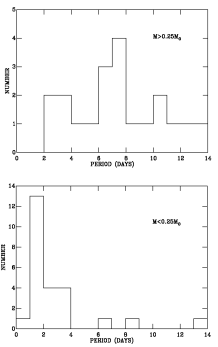IC348
Paper | Table | Catalogue | Link | |
| Bell et al (2013) | 13 | Full ugriz catalogue | FITS | gzipped ASCII |
| 14 | Members | FITS | gzipped ASCII | |
| Novarflag | FITS | gzipped ASCII | ||
| Mayne et al (2007) | 13 | BVI photometric catalogue | ASCII | |
| Periodic objects from Littlefair et al (2005) | ASCII | |||
| 14 | X-ray sources from Preibisch & Zinnecker (2002) | ASCII | ||
| 14 | X-ray sources from from the Second ROSAT PSPC catalogue | ASCII | ||
| 15 | Spectroscopic members from Luhman et al (2003) | ASCII | ||
| 17 | Hα sources from Herbig (1998) | ASCII | ||
| Littlefair et al (2005) | Periodic objects | Data Server | ||
| Objects we could not derive a period for | Data Server |
 Littlefair et al (2005)
describes our discovery of the rotation period for 32 stars in IC348.
We have made available a great deal of supplementary information
for this dataset.
First there is the catalogue
of sources we observed.
You can also access plots and data files for all the objects which have
decent lightcurves.
We obtained three lightcurves for each object, with exposure times of
2s, 30s and 300s.
Rather than presenting all these, we have chosen the best one for the
source in question.
For the objects with periods, we've chosen the lightcurves from which
the period was determined, with three exceptions.
In the cases of stars 21, 55 and 147 we chose
the 30s lightcurves as they contained data from more nights than the
300s ones, and thus make a more convincing case that the period is real.
The lightcurve, periodogram, folded
lightcurve and finding chart can be accessed via the
catalogue of objects for which we derived periods.
For those objects where we failed to find a credible period we
normally present
the lightcurve with the highest signal-to-noise and more than 50 data
points.
However,
in the cases of stars 79 and 135 there were many
more data points in the 30s lightcurves we present than the 300s we would
otherwise have chosen.
These lightcurves, along with periodograms and finding charts are
available via the
catalogue of objects where we couldn't find a period.
Littlefair et al (2005)
describes our discovery of the rotation period for 32 stars in IC348.
We have made available a great deal of supplementary information
for this dataset.
First there is the catalogue
of sources we observed.
You can also access plots and data files for all the objects which have
decent lightcurves.
We obtained three lightcurves for each object, with exposure times of
2s, 30s and 300s.
Rather than presenting all these, we have chosen the best one for the
source in question.
For the objects with periods, we've chosen the lightcurves from which
the period was determined, with three exceptions.
In the cases of stars 21, 55 and 147 we chose
the 30s lightcurves as they contained data from more nights than the
300s ones, and thus make a more convincing case that the period is real.
The lightcurve, periodogram, folded
lightcurve and finding chart can be accessed via the
catalogue of objects for which we derived periods.
For those objects where we failed to find a credible period we
normally present
the lightcurve with the highest signal-to-noise and more than 50 data
points.
However,
in the cases of stars 79 and 135 there were many
more data points in the 30s lightcurves we present than the 300s we would
otherwise have chosen.
These lightcurves, along with periodograms and finding charts are
available via the
catalogue of objects where we couldn't find a period.
In Mayne et al (2007) we generate an empirical
isochrone for IC348 and argue that IC348 is 3-4 years old. This new
age could reveal important evidence for the effects of local
environment on stellar evolution. As the distribution of rotational
periods is similar to the ONC and the disc fraction is higher than
expected for such an old cluster, both could be due to the relative
quiescence of the environment of IC348.
We present the
photometry of:
all stars in
the FOV;
Periodically
variable stars
from Littlefair
et al (2005);
X-ray
sources from
Preibisch & Zinnecker (2002);
X-ray sources from the
Second ROSAT PSPC catalogue;
Spectroscopy from
Luhman et al (2003) and
H&alpha sources from
Herbig (1998) .